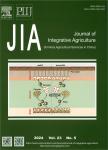Effect of Astragalus polysaccharides on Erythrocyte Immune Adherence of Chickens Inoculated with Infectious Bursal Disease Virus
Effect of Astragalus polysaccharides on Erythrocyte Immune Adherence of Chickens Inoculated with Infectious Bursal Disease Virus作者机构:College of Veterinary Medicine and Animal Science Shanxi Agricultural University Taigu 030801 P.R.China Schools of Veterinary Science Seddon Buildings University of Queensland Brisbane QLD 4072 Australia
出 版 物:《Agricultural Sciences in China》 (中国农业科学(英文版))
年 卷 期:2007年第6卷第11期
页 面:1402-1408页
学科分类:090603[农学-临床兽医学] 09[农学] 0906[农学-兽医学]
主 题:Astragalus polysaccharides chicken infectious bursal disease virus (IBDV) erythrocyte immune modulation herbal therapy
摘 要:Two hundred and forty specific pathogen free leghorn chickens were randomly divided into four groups and reared in isolated pens. The tested chickens were negative to infectious bursal disease virus (IBDV) at 25 d old. Group 1 was treated with saline, whereas Groups 2, 3, and 4 were inoculated with 0.3 mL IBDV suspension intranasally the next day. Groups 3 and 4 were also administered with Astragalus polysaccharides (APS) intramuscularly twice daily at 5 or 10 mg kg-1 BW, respectively, until 31 d old. The erythrocyte-C3b receptor rosette rate (E-C3bRR) and the erythrocyte-C3b immune complex rosette rate (E-ICRR) were measured at 25, 29, 32, 35, and 38 d old. The results showed that IBDV significantly reduced E-C3bRR and E-ICRR when compared with the control group (P 〈 0.05), while simultaneous administration of APS with 1BDV maintained E-C3bRR at similar levels to the control group (P 〉 0.05) and increased E-ICRR when compared with the control group and the group non-treated with APS (P 〈 0.05). APS treatment reduced the morbidity and mortality of chickens inoculated with IBDV (P 〈 0.05). The results suggest that APS may enhance the immune adherence of chickens erythrocytes by affecting the activity and/or the number of complement receptors on the erythrocyte membrane. These findings can be beneficial in providing an understanding of the basic mechanisms required for the rational application of APS in modern medicine.



